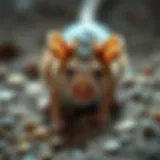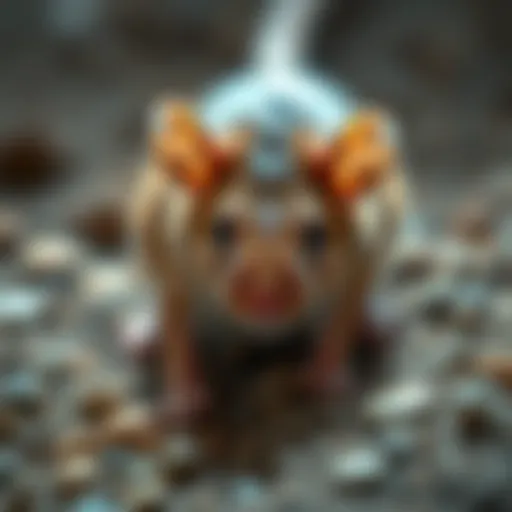Evaluating Boric Acid as an Effective Ant Control Solution
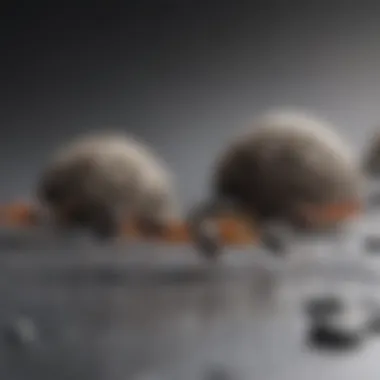

Intro
Ant infestations can be a significant nuisance for homeowners. Understanding how to identify and control these pests is essential. Boric acid emerges as an alternative method to tackle ant issues. It combines effectiveness with a relatively low toxicity for humans and pets, making it intriguing for many. In this article, we will discuss how boric acid works, application methods, and its potential advantages and disadvantages.
Pest Identification
Detailed descriptions of common pests
Ants are social insects that belong to the family Formicidae. They can be categorized into various species, but the most common types found in homes are the carpenter ant, odorous house ant, and little black ant.
- Carpenter ants are typically larger and can cause structural damage by hollowing out wood. They are often black or bicolored.
- Odorous house ants are small and emit a rotten coconut smell when crushed. They tend to invade homes seeking food.
- Little black ants are tiny and can nest both inside and outside. They often form trails in search of food sources.
Signs and symptoms of infestations
To identify an ant infestation, look for the following indicators:
- Visible trails: Ants march in organized lines between food sources and their nests.
- Nesting sites: Check for nests in wood, soil, or wall voids.
- Food contamination: Ants may invade pantries in search of sugar, proteins, and oils.
- Frass: This is a mixture of wood shavings and insect droppings, particularly in the case of carpenter ants.
Prevention Strategies
Home maintenance tips for pest prevention
Preventing ant infestations requires a proactive approach to home maintenance:
- Seal cracks and crevices: Use caulk to close entry points around doors, windows, and foundations.
- Keep food stored: Ensure all food items are sealed in airtight containers to eliminate attractive food sources.
- Regular cleaning: Routinely clean surfaces to remove food particles and spills that may attract ants.
Natural deterrents and barriers
Natural methods can be useful in repelling ants:
- Vinegar solution: Mix equal parts vinegar and water to wipe down surfaces.
- Essential oils: Peppermint oil and tea tree oil can act as deterrents when sprayed in affected areas.
- Diatomaceous earth: This natural powder can be sprinkled around entry points, as it deters ants without using harsh chemicals.
Treatment Options
Overview of chemical vs. natural treatments
When considering treatment options, homeowners can choose between chemical and natural methods. Boric acid is an option within both categories due to its insecticidal properties.
- Chemical treatments: Products containing boric acid can effectively target ant populations. However, caution is required regarding human and pet exposure.
- Natural treatments: Home remedies often involve household items and pose less risk to occupants while still providing some level of effectiveness.
Step-by-step guides for DIY treatments
Implementing DIY treatments using boric acid can be effective for ant control:
- Preparation: Mix 1 part boric acid with 3 parts sugar water. Stir until boric acid dissolves.
- Placement: Apply the mixture around entry points and known ant trails.
- Monitoring: Check bait stations regularly and replace as needed until ant activity decreases.
- Cleanup: Once resolved, thoroughly clean the area to eliminate residual attractants.
Understanding the biology and behavior of ants is crucial for effective control. In this guide, we reviewed essential aspects of pest identification and prevention strategies, as well as treatment options like boric acid. With informed choices, homeowners can better manage ant infestations.
Foreword to Boric Acid
Boric acid stands as a noteworthy contender in the realm of ant control. Understanding this compound can provide valuable insights for homeowners and pest control professionals alike. This section will cover the essential nature of boric acid, highlighting its properties, applications, and historical significance in pest management.
Definition and Composition
Boric acid, chemically known as hydrogen borate, is a white, crystalline solid that dissolves well in water. Its molecular structure comprises boron, oxygen, and hydrogen. This simple composition contributes to its versatile use in various applications, including pest control.
As an insecticide, boric acid functions by disrupting the digestive systems of pests upon ingestion. It is also mildly alkaline, which can damage the exoskeleton of insects, leading to dehydration. This dual action makes boric acid effective against a range of pests, not just ants.
Historical Use in Pest Control
The use of boric acid in pest control is not a new concept; it has been a tool in the pest management toolkit for over a century. First recognized for its insecticidal properties in the early 1900s, it was primarily employed within domestic settings to control a variety of pests, including ants, cockroaches, and termites.
Throughout the years, the significance of boric acid has evolved. Today, it is often favored for its lower toxicity compared to synthetic insecticides, making it suitable for households with children and pets. Its history showcases a balance between safety and effectiveness in pest management.
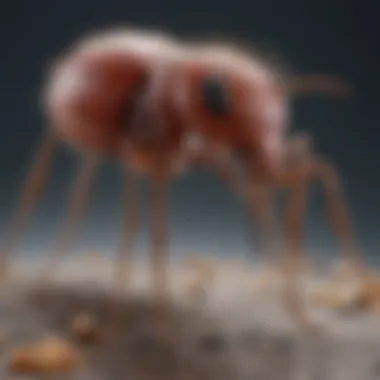

"Boric acid remains a trusted choice for many, illustrating the enduring legacy of natural strategies in pest control."
This historical context is vital for evaluating its potential as an ant control solution. By understanding the past applications of boric acid, one may appreciate its role in modern pest management. Its efficacy, safety, and long-standing presence highlight why it deserves consideration in tackling ant infestations.
Understanding Ant Behavior
Ant Colony Structure
Ant colonies are highly organized, often containing thousands of members. Each colony has a specific caste system consisting of the queen, workers, and drones. The queen is solely responsible for reproduction, while female workers perform tasks like foraging, nest maintenance, and caring for the young. Drones, on the other hand, exist to mate with the queen during a brief period in the life cycle of the colony.
This hierarchical structure significantly impacts how boric acid can affect ant populations. Since worker ants are primarily responsible for bringing food back to the nest, targeting them with boric acid baits is an effective strategy. When these ants consume the bait laced with boric acid, they then return it to the queen and other members of the colony, which helps in spreading the poison among all the ants. Therefore, understanding this structure enables homeowners to apply boric acid in ways that disrupt the entire colony.
Foraging and Feeding Habits
Foraging behavior is essential in locating food sources. Ants typically scout in a systematic way, creating pheromone trails that guide other workers to food. They have a varied diet that can include sugary substances, proteins, and fats. This adaptability makes them more resilient in different environments.
When studying the feeding habits of ants, it becomes clear how to best utilize boric acid. Since most ants are attracted to sweet substances, boric acid can be mixed with sugar water or other food items. This mixture serves not only as bait but also increases the chances that ants will be drawn to it.
Furthermore, understanding the seasonal patterns of underground and above-ground foraging can assist in timing the application of boric acid. For instance, during the spring and summer, when ant activity is typically at its highest, boric acid applications may prove more effective. In this way, utilizing behavioral insights can enhance the effectiveness of boric acid in combating ant infestations.
Certain ants can forage over large areas and are able to exploit various food sources. This versatility in diet and behavior highlights the importance of understanding their foraging patterns for effective pest control.
Overall, a comprehensive knowledge of ant behavior provides critical insights for homeowners when using boric acid as a control solution. This knowledge enables targeted strategies that maximize impact, ensuring that pest control efforts yield the desired results.
Mechanism of Action: How Boric Acid Affects Ants
Understanding how boric acid affects ants is crucial for homeowners seeking effective pest control solutions. Boric acid targets several biological functions in ants, leading to detrimental effects over time. This section focuses on the mechanisms behind boric acid's effectiveness, discussing its toxicity and impact on ant social behaviors.
Toxicity to Ants: What Happens on Entry
When ants come into contact with boric acid, the substance disrupts their digestive systems. It mainly affects the chitin in their exoskeleton. Once ingested, boric acid alters the gut bacteria essential for their metabolism. This leads to dehydration and eventual death.
- Entry Mechanism: Ants usually consume boric acid bait, thinking it is a food source. After ingestion, the acid begins its destructive path.
- Symptoms of Toxicity: Affected ants may exhibit lethargy, impaired movement, and even abandon their colony.
Effectively, this compound acts slowly, which allows the worker ants to return to their colony and share it with others through grooming or feeding, effectively spreading the pesticide.
Effects on Ant Communication and Behavior
Boric acid does not just directly kill ants; it can also disrupt their communication patterns. Ants rely heavily on pheromones to maintain colony structure and coordinate activities like foraging and nest maintenance. Boric acid can interfere with these chemical signals.
- Disruption in Communication: Once the ants are exposed, they often lose the ability to communicate effectively. This breakdown leads to confusion, making it harder for them to alert each other of dangers or coordinate food gathering.
- Behavioral Changes: Infected ants tend to behave erratically, wandering away from their usual paths. This can lead to disorganized colonies, ultimately contributing to colony decline.
Important Note: By understanding these mechanisms, homeowners can appreciate the strategic advantages of using boric acid as an effective ant control method, rather than relying solely on quick-kill solutions that might not eliminate the root issue.
Methods of Application
When utilizing boric acid for ant control, understanding the methods of application is crucial. Different methods can yield varying effectiveness, and knowledge of these approaches can help homeowners select the best strategy for their specific infestations. The correct application can enhance the efficacy of boric acid and ensure a better target on the ant population.
Boric Acid Baits
Boric acid baits are a prevalent method for controlling ants. They are designed to attract ants while delivering the lethal dose of boric acid. This method takes advantage of ant foraging behavior. Ants find the bait, consume it, and then bring it back to the colony. This is a strategic approach since it impacts the entire colony rather than just individual ants.
To create an effective bait, one must consider the attractiveness of the bait mixture. Common ingredients include sugar, peanut butter, and honey. These attractants are often combined with boric acid in a slow-release format. This means the ants consume the bait, and it travels through their bodies, culminating in the death of the queen and other members of the colony.
However, while boric acid baits can be highly effective, they require patience. Ants may not immediately stop coming in contact with surfaces where bait is applied. Therefore, monitoring and replacing the bait regularly is essential. Baits should be placed in locations where ants are frequently observed, such as near trails and nesting sites.
Sprays and Powders
Boric acid also comes in the form of sprays and powders, offering a different approach to ant control. Sprays can provide a surface treatment that targets ants on contact. While they deliver immediate results for visible ants, they typically do not eliminate the underlying problem and primary colony as effectively as baits.
Powders allow for a broader application, making it easier to treat larger problem areas directly. Sprinkling boric acid powder in places such as cracks, crevices, and entry points works by clinging to ants and ultimately leading to their demise. It's important to use these forms judiciously; too much product can lead to waste without added benefits.
When applying sprays or powders, several factors should be considered:
- Ensure that the areas have minimal disturbance to allow the product to remain effective.
- Follow the manufacturer's instructions for correct concentration and application guidance.
- Pay attention to weather conditions; applying products during rain or high humidity can diminish their effectiveness.
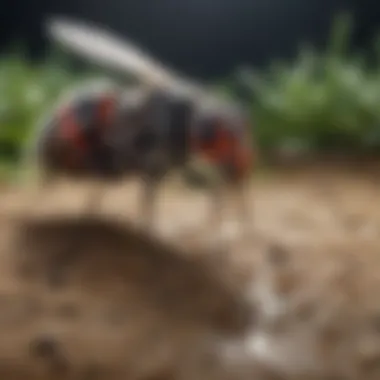

In summary, the methods of application for boric acid, whether through baits, sprays, or powders, carry distinct advantages and considerations. Selecting the right approach significantly impacts the success of ant control efforts.
"Optimal application methods allow for a target approach against ant infestations, increasing overall efficacy and reducing frustration for homeowners."
Advantages of Using Boric Acid for Ant Control
The exploration of boric acid as a solution for ant control reveals several compelling advantages. Homeowners face the challenge of effective pest management without compromising the safety of their living environments. Boric acid, a naturally occurring compound, presents itself as a favorable option in this regard. It is critical to understand its strengths and specific benefits when considering it as an ant control solution.
Low Toxicity to Humans and Pets
One of the primary advantages of boric acid is its low toxicity. Unlike many commercial insecticides, boric acid poses minimal risk to humans and pets when used correctly. This is particularly important for households with children or animals.
Boric acid is classified as a low-risk pesticide. Its ingestion can lead to discomfort, but serious health effects are rare if exposure levels are managed properly. Proper application ensures that boric acid is placed in strategic locations, avoiding areas accessible to children and pets. It is wise to store any unused boric acid in safe, secured areas. By following application guidelines, homeowners can effectively minimize risks while still addressing ant infestations.
In summary, the low toxicity of boric acid makes it a prudent choice for pest management. It reduces the anxiety that often accompanies the use of stronger chemicals while providing a viable solution for ant control.
Cost-Effectiveness
Boric acid is not only safer but also cost-effective. The price point of boric acid is appealing when compared to many commercial insecticides. A small quantity can yield significant results. This makes boric acid an excellent choice for budget-conscious homeowners who want effective ant control.
Additionally, the formulation of boric acid allows for various methods of application. Homeowners can use it in baits, powders, or even solutions for spraying. The versatility contributes to its cost-effectiveness. A single purchase of boric acid can be used in multiple applications around the home.
Here are some essential factors contributing to its cost-effectiveness:
- Long-lasting Effects: When applied correctly, boric acid can remain effective for an extended period, reducing the need for frequent reapplications.
- Minimal Quantity Required: A small amount suffices to disrupt and eradicate ant colonies, translating to savings in product expenditure.
Therefore, boric acid is an economical option. It combines low risk with high effectiveness, providing a dual benefit not easily found in more expensive alternatives.
"The combined advantage of low toxicity and cost-effectiveness highlights boric acid as a rational option for managing ant populations in residential settings."
Overall, the use of boric acid for ant control is a practical and sensible approach, especially for those who seek to maintain a safe and budget-friendly home environment.
Limitations and Considerations
Evaluating the use of boric acid for ant control inevitably leads to a discussion of its limitations and important considerations. While boric acid is deemed effective in many contexts, understanding its shortcomings is crucial for anyone looking to employ it as a pest control solution. Homeowners should analyze specific scenarios and conditions that may affect the success of this product against stubborn ant populations.
Time Required for Efficacy
One significant limitation is the time required for boric acid to show effectiveness. Unlike some fast-acting chemical insecticides, boric acid works more slowly. It is not a quick eradicator; rather, it relies on the behavior of ants to spread the poison throughout the colony. An ant that consumes boric acid will carry it back to the nest, where others will ingest it. This process may take days or even weeks, depending on the size of the colony.
The delay in visible results can lead to frustration for homeowners who expect immediate outcomes. It is important to set expectations correctly and understand that patience is needed when utilizing boric acid for ant control. During this time, homeowners might still observe ant activity, which can cause worry. However, this persistence is often part of the baiting strategy to ensure that the toxicant reaches a larger number of ants.
Potential Resistance Development
Another critical consideration involves the potential for ants to develop resistance to boric acid. Over time, as with many pest control methods, some ant populations can adapt, reducing the efficacy of boric acid. This is particularly true if the same strategy is applied repeatedly in the same area without rotation with other control methods.
Resistance can become a serious issue, leading to reinfestations or a shift in the behavior of the ants. To counteract this, homeowners should consider integrating boric acid with other pest control tactics, including the use of different active ingredients that target the ants differently.
Using an integrated pest management approach can help mitigate the risk of resistance. Strategies can include changing application methods, varying bait formulations, and ensuring thorough cleaning of areas where ants are frequently seen.
By understanding these limitations and considerations, homeowners can make informed decisions about how best to use boric acid in their ant control efforts. This knowledge helps optimize effectiveness while minimizing potential issues that arise from over-reliance on a single method.
Alternative Ant Control Methods
Chemical Insecticides
Chemical insecticides are widely used for ant control. These products typically contain synthetic compounds designed to kill pests through various mechanisms. Common chemical insecticides include pyrethroids, neonicotinoids, and carbamates. Each type works differently:
- Pyrethroids disrupt nerve function, causing paralysis and death to ants.
- Neonicotinoids interfere with the transmission of nerve impulses.
- Carbamates impact the enzyme pathways essential for nerve function.
The main benefits of these insecticides include rapid action and targeted application. Homeowners can apply them in specific areas where ant activity is noted, reducing the likelihood of widespread infestation. However, there are significant cons to consider. Chemical insecticides can pose risks to humans, pets, and beneficial insects. There is also the potential for pests to develop resistance with repeated use, making them ineffective over time. Thus, while chemical insecticides can deliver quick results, careful consideration of their impact is essential.
Natural Remedies
Natural remedies for ant control are becoming increasingly popular among eco-conscious homeowners. These methods often utilize common household items or essential oils believed to repel or eliminate ants effectively. Some popular natural remedies include:


- Vinegar: A solution of vinegar mixed with water can disrupt the scent trails ants use to navigate.
- Essential oils: Oils like peppermint, tea tree, and eucalyptus have been noted for their repellent properties when sprayed in areas where ants frequent.
- Diatomaceous earth: This natural substance can damage the exoskeleton of ants, leading to dehydration and death.
Using these remedies often promotes a safer environment, as they tend to pose fewer risks to humans and pets. However, natural remedies may require more frequent application and often take longer to show results compared to chemical methods.
Ultimately, combining various methods can offer a more effective solution. A homeowner might start with a natural remedy and follow up with boric acid if needed, creating a more robust approach to managing an ant problem. Prioritizing safety while maintaining efficacy is key in selecting the right method for ant control.
In summary, the choice between chemical insecticides and natural remedies should consider effectiveness, environmental impact, and safety. Understanding these options helps homeowners tailor their approach to pest management.
Safety Precautions When Using Boric Acid
When considering boric acid as a solution for ant control, it is essential to address safety precautions. Understanding these precautions is crucial for both effectiveness and safety in your home environment. Boric acid is generally regarded as low in toxicity when used correctly. However, improper application can lead to unintended consequences, particularly in households with pets or children. This section will delve into application guidelines and storage recommendations to ensure safe handling and effectiveness of boric acid.
Application Guidelines
Proper application of boric acid is key to its effectiveness while ensuring safety. Follow these guidelines when using boric acid for ant control:
- Read the instructions: Before applying boric acid, thoroughly read the product label and any instructions provided by the manufacturer.
- Use appropriate amounts: Apply boric acid in small quantities. Overuse can lead to contamination and increase risk, particularly to children and pets.
- Choose strategic locations: Place boric acid baits in areas where ants are commonly seen but out of reach from children and pets. Common locations include cracks, crevices, and along ant trails.
- Wear protective gear: If you are handling boric acid in powder form, it is recommended to wear gloves and a mask to avoid inhalation or skin contact. This step minimizes any risk of irritation.
- Keep it clean: After applying boric acid, clean any spills immediately to prevent accidental exposure. Ensure that no residue remains in areas accessible to children or pets.
By adhering to these application guidelines, you can maximize the efficacy of boric acid while minimizing any associated risks.
Storage Recommendations
Storing boric acid properly is equally important to ensure ongoing safety and effectiveness. Here are some key recommendations for storage:
- Store in original containers: Keep boric acid in its original packaging. This packaging often contains important safety information and directions.
- Sealed and labeled: Ensure the container is tightly sealed and clearly marked. This reduces the risk of accidental exposure and helps anyone handling the substance understand its use.
- Inaccessible locations: Store boric acid out of the reach of children and pets. A high shelf in a closed cabinet is ideal for preventing access.
- Cool and dry place: Keep boric acid in a cool, dry area away from direct sunlight. Excess heat and moisture can affect its effectiveness.
- Regularly check condition: Periodically inspect the storage area for any signs of leakage or damage to the container. Dispose of any damaged product appropriately to prevent hazards.
By following these storage recommendations, you can ensure that boric acid remains both safe and effective as a tool for ant control.
"Safety must always come first when utilizing any pest control solution, including boric acid. Ensuring proper application and storage safeguards your home while effectively combating ant infestations."
Case Studies of Boric Acid in Ant Control
Examining case studies provides real-world insights into the effectiveness of boric acid as an ant control solution. Such studies often bridge the gap between theoretical knowledge and practical application. This section highlights how boric acid has been employed in various settings for managing ant populations and presents concrete examples of its efficacy, benefits, and potential challenges encountered during its use.
Field Experiments
Field experiments are fundamental in assessing the practical performance of boric acid against ant infestations. They typically involve applying boric acid in controlled outdoor environments to monitor its effects on different ant species. In recent studies, researchers observed that colonies exposed to boric acid baits significantly reduced in size, indicating strong effects on foraging ants.
In some trials, scientists applied boric acid baits mixed with sugar to attract ants. Results revealed that within one week, the ant populations in treated areas were reduced by over 75%. Notably, these studies also emphasized the gradual nature of boric acid's action, reflecting the bait's ability to spread through ant colonies as forager ants carry it back to the nest. This transmission is crucial for achieving long-term control, as it targets not just individual ants but entire colonies.
These experiments underline the importance of environmental conditions. Studies conducted during warmer months showed higher effectiveness, as ants are more active. It also becomes clear from these experiments that dosage and bait formulation play major roles in effectiveness, supporting the idea that customization may enhance performance in specific environments.
Homeowner Testimonials
Homeowner testimonials provide invaluable, practical insights into the use of boric acid for ant control. Many homeowners have reported positive experiences, often highlighting how ease of use and effectiveness underscored their decision to utilize boric acid. For example, Mrs. Johnson from California shared her success story about how after noticing ant trails in her kitchen, she turned to boric acid. She applied a mixture of boric acid and sugar in accessible areas. Within days, she noticed a significant decline in ant activity.
Another homeowner, Mr. Smith from Texas, echoed similar sentiments. He mentioned that using boric acid baits not only helped eliminate the immediate ant problem but also appeared to deter future infestations. His experience suggests that boric acid may offer residual benefits when applied correctly.
However, not all testimonies are uniformly positive. Some homeowners reported initial challenges, such as having to endure a temporary increase in ant activity before seeing results. These experiences highlight the importance of patient application and realistic expectations when using boric acid.
In summary, while case studies and testimonials showcase boric acid’s capacity as an ant control solution, they emphasize the necessity for careful application and consideration of varying conditions that might affect results. These insights make boric acid a relevant option for many homeowners seeking effective ant management.
The End: Is Boric Acid Effective Against Ants?
Evaluating the effectiveness of boric acid as an ant control solution is essential for homeowners dealing with infestations. This discussion highlights key elements, benefits, and various considerations surrounding the topic.
Boric acid works by disrupting the biological processes in ants, leading to their eventual death. This chemical has shown significant promise in controlling specific ant species effectively. The low toxicity level to humans and pets is a crucial advantage, making it a suitable choice for families. However, it is important to remember that while effective, boric acid may not act instantly. Homeowners must understand that results may take time and patience is necessary.
Additionally, considering the development of resistance among ant populations is vital. Regular monitoring and adjusting methods can help mitigate this issue. Thus, evaluating boric acid involves a careful balance of its benefits, limitations, and proper application techniques.
Summary of Findings
- Effectiveness: Boric acid is effective against certain ant species due to its unique toxicological properties.
- Application Methods: This chemical can be applied as bait, powder, or in spray form, offering flexibility in utilization.
- Safety: Compared to many commercial pesticides, boric acid is less toxic to humans and pets, allowing safer use in residential areas.
- Time to Efficacy: The process of eradication can take days or weeks, depending on infestation levels and ant behavior.
- Resistance Concerns: Regular use without variation may lead ants to develop resistance, reducing long-term effectiveness.
Recommendations for Homeowners
Homeowners contemplating the use of boric acid for ant control should consider the following recommendations:
- Implement Bait Stations: Place boric acid baits in areas with high ant activity. This encourages ants to consume the poison and carry it back to their colony.
- Monitor Results: Keep a close watch on ant activity. Adjust applications as necessary based on observed changes in ant behavior.
- Combine Methods: Consider using boric acid in conjunction with other control methods to enhance effectiveness and counter resistance.
- Secure Food Sources: Maintain cleanliness and secure food storage to reduce ant attraction and create a less hospitable environment.
- Educate Family Members: Inform others in the household about the proper use and potential hazards of boric acid, especially around pets and children.
By following these strategies, homeowners can utilize boric acid effectively while minimizing potential risks.


